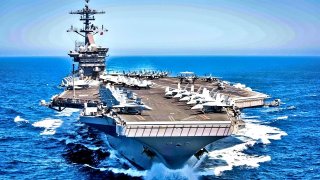USS Theodore Roosevelt: What Makes This Navy Aircraft Carrier a Powerhouse
The USS Theodore Roosevelt made her maiden deployment on December 30, 1988, patrolling the Mediterranean Sea for six months as part of Carrier Air Wing Eight.
USS Theodore Roosevelt, a Primer: Theodore Roosevelt looms large, even relative to his presidential peers. The name Theodore Roosevelt is associated with swaggering adventurism, with ‘carrying a big stick – an apt name for an aircraft carrier.
The USS Theodore Roosevelt is the fourth Nimitz-class carrier. Named for the 26th President of the United States, the Theodore Roosevelt is the fourth U.S. Navy vessel to bear Theodore Roosevelt’s name – while yet another three bear the Roosevelt name. Without question, the nuclear-powered aircraft carrier is the most significant.
USS Theodore Roosevelt: CVN-71: *almost* Canceled
Designated CVN-71, the Theodore Roosevelt was launched in 1984, commissioned in 1986, and has been in service ever since. Yet CVN-71 almost never entered service. Actually, President Gerald Ford canceled the CVN-71 order in 1976, opting instead for two CVV-type medium-sized conventional-powered carriers, which would have been able to launch V/STOL aircraft.
Ford’s ousting from the White House didn’t initially change the fate of the Theodore Roosevelt; President Jimmy Carter shot down the project, vetoing the 1979 Fiscal Year Department of Defense authorization bill because the bill included the Theodore Roosevelt.
Carter, a submarine officer turned peanut farmer turned governor, did not want to fund another nuclear-powered carrier. Intervening events persuaded Carter to change his mind. When Iranian revolutionaries took U.S. embassy workers hostage in 1979, the U.S. had an increased need for carrier deployment in the Middle East – and Carter had an increased need to not appear weak in military terms. So in 1980, Carter authorized funding for the Theodore Roosevelt.
The ship was laid down in 1981, about five years after being canceled. And when the ship was finally launched in 1984 the carrier donned an appropriate radio call sign: “Rough Rider,” which, of course, was the nickname of Roosevelt’s volunteer cavalry unit during the Spanish-American War.
CVN-71: On the Cutting Edge
To assemble the Theodore Roosevelt, a virtual floating city, Newport News Shipbuilding used a then-new technique known as modular construction. To build a ship with modular construction, large modules are constructed independently of one another in “lay-down” areas.
Once the modules are built independently, they are hoisted into place and welded together. Building a ship with modular construction requires massive gantry cranes, each capable of lifting 900 tons – a technical marvel in and of themselves.
Fortunately, the modular construction worked well on the Theodore Roosevelt, shaving an estimated 16 months off the total construction time and changing the way aircraft carriers were built. Every aircraft carrier since the Theodore Roosevelt has been built using modular construction.
The finished construction measured 1,092 feet long (1,040 feet at the waterline) and displaced 104,600 tons. Powering the Theodore Roosevelt were 2 Westinghouse A4W nuclear reactors and four steam turbines driving four shafts to propel the ships’ massive propellers.
The end result: a 30-plus knot top speed and an unlimited range. The USS Theodore Roosevelt, like all nuclear-powered submarines, was a feat of modern engineering, capable of operating for 20-25 years, with only food and supplies limiting the ships’ endurance.
CVN-71: At Sea
The Theodore Roosevelt made her maiden deployment on December 30, 1988, patrolling the Mediterranean Sea for six months as part of Carrier Air Wing Eight. The 1990s were somewhat more eventful for the Theodore Roosevelt; the ship was deployed to the Persian Gulf for Operation Desert Storm in January of 1991.
The Theodore Roosevelt participated prominently in the war, launching over 4,200 sorties – more than any other U.S. aircraft carrier. Before the war ended in a cease-fire in February, aircraft launched from the Theodore Roosevelt dropped an estimated 4.8 million pounds of ordnance.
In 1993, CVN-71 received a special visitor: President Bill Clinton, who spent his time talking about the Theodore Roosevelt for several hours while she was off the coast of Virginia. Other international deployments followed, with the Theodore Roosevelt participating in Operation Deny Flight, Operation Southern Watch, and Operation Deliberate Force.
The Theodore Roosevelt was back in domestic waters, off the cost of North Carolina, when she collided with the USS Leyte Gulf in 1996. The Leyte Gulf was a Ticonderoga-class guided missile cruiser.
The collision was the Theodore Roosevelt’s fault; without warning, the 1,092-foot-long aircraft carrier reversed course – while directly in front of the Leyte Gulf. The Theodore Roosevelt’s stern collided with the Leyte Gulf’s bow, causing seven million and two million dollars worth of damage respectively. Fortunately, no one was injured.
CVN-71 is still in service, seeing regular action through the aughts, being deployed after the September 11th attacks to support Operation Enduring Freedom.
In 2002, the Theodore Roosevelt spent 160 consecutive days at sea, the longest time a US Navy vessel had spent underway since World War II.
In 2021, the Theodore Roosevelt was retrofitted to accommodate the F-35 Joint Strike Fighter, suggesting that the carrier will be a part of the fleet for the foreseeable future.
Harrison Kass is a prolific defense and national security writer. An attorney, pilot, guitarist, and minor pro hockey player, Harrison joined the US Air Force as a Pilot Trainee but was medically discharged. Harrison holds a BA from Lake Forest College, a JD from the University of Oregon, and an MA from New York University. Harrison listens to Dokken.
All images are Creative Commons.

